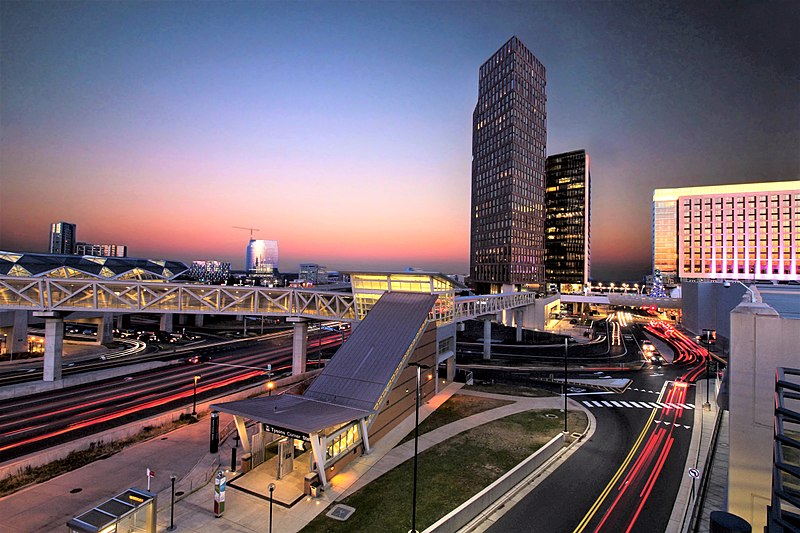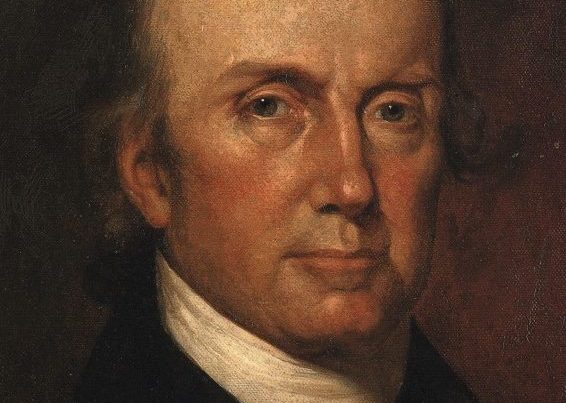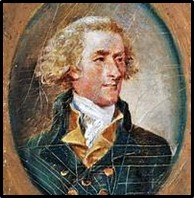
On March 15, John T. “Til” Hazel Jr. died in Broad Run, Fauquier County, Virginia. There’s no reason why you should necessarily know the name, though if you have spent any time in the Northern Virginia suburbs of Washington, D.C., you have witnessed first-hand his tremendous influence. Joel Garreau in his 1992 book Edge City: Life on the New Frontier declared that Hazel “has done more to shape the Washington area than any man since Pierre L’Enfant,” the man who designed the plan for the District of Columbia.
Hazel’s obituary in the Washington Post noted that the Virginia lawyer and developer had played a “crucial role in building the Capital Beltway and transforming Northern Virginia from a rural outpost of Washington into an economic powerhouse.” It was Hazel who was behind the building of much of the region’s highway, suburban subdivision and shopping center infrastructure, “forever altering the way Washingtonians live.” Forer George Mason University president George Johnson went so far as to say that “Til Hazel defined Northern Virginia. He imagined it, he brought it about, he led it and behind the scenes did more building of the community than anyone. He tried to give it an identity.”
In the process of giving Northern Virginia an “identity,” Hazel won legal battles against environmentalists and other growth opponents in order to reaffirm property rights and allow residential and commercial building to proceed. Today, one in every ten residents in Fairfax County live in a home developed by Hazel. Even GMU, now a world-renowned academic institution (and former Final Four contender), owes much of its current prominence to Hazel, who was twice its rector. Tysons Corner, Fair Lakes, Franklin Farm, Burke Centre, and Fairfax Station, if you’ve heard of them, all owe their current existence as prominent residential or commercial zones to Hazel. So does Dulles International Airport.
It’s quite a legacy for a man who, though he grew up in the now very metropolitan Arlington County, never lost his Virginia drawl. One of his grandfathers was president of an Arlington bank, and an uncle was the Arlington commonwealth’s attorney. His father bought a farm in McLean, now one of the toniest parts of Fairfax County, in order to raise crops to feed his family during the Depression. Til Jr. would bicycle or hitchhike from Arlington to plow its fields. Yet after multiple degrees from Harvard, and the Army Judge Advocate General’s Corps, he landed in development, first as a lawyer representing major developers in Fairfax County in the 1960’s.
Much of my life, and that of my extended family, revolves around the decisions made by Mr. Hazel. I was born in Arlington, was raised on the boundary of Fairfax Station and Lorton, had my first job in Burke Centre, and bought my first house in Fair Lakes. For ten years I have attended a church right next to Franklin Farm. One of my grandfathers moved from southern Maryland to Northern Virginia in the 1960’s, started his own dental supply business, and did much work in Burke and Fairfax. One of my uncles (his elder son) worked for many years in Tysons, and like the now deceased Hazel, lives in one of the few remaining rural parts of neighboring Loudoun County — he also attended one of Hazel’s daughter’s weddings.
I must confess that as a lifelong resident of Northern Virginia, I have very mixed feelings about Mr. Hazel and the broader social and economic trends his life represents. I cannot imagine a life apart from the one that he helped create. I was baptized at a Catholic parish in Burke, and two of my children were born in Fair Lakes.
Yet the things I love most about my native Northern Virginia are the things Hazel most adamantly sought to destroy in his attempts to fashion a new “identity” for the region. Growing up in one of the last rural parts of Fairfax County, our house was still in walking distance to multiple working farms. My friend and I would regularly walk through the woods to feed carrots to a neighbor’s horses, and I remember local farmers selling their crops on the side of the road. Those days are gone. On land where once stood old farms are now gaudy Mcmansions.
Also gone is the Southern culture. The folks across the street, who had grown up in Alexandria in the 1950s, had thick Virginia accents — good luck finding such drawls there now. A Southern-style restaurant in Old Town Fairfax called Black Eyed Pea is now an Irish pub. Farms that dotted the drive out Lee-Jackson Memorial Highway to my uncle’s fifteen-acre lot in Unison are now uninspiring subdivisions in made-up “towns” like South Riding, which didn’t exist until 1995, and are as soul-crushing as they are boring and ugly.
My elementary school, which was within sight of the old St. Mary’s Catholic Church, where Clara Barton did her first nursing, was one of the oldest schools in Fairfax County, built in 1899. It was originally a frame one-room building. Several of my teachers had thick Virginia accents, and I remember one of them describing what the area had been like before Hazel and co. had begun major development of the area in the 1970s and 1980s. Now the school’s web page is not only in English, but Spanish, Vietnamese, Korean, Chinese Urdu, Arabic, and Farsi, reflecting the reality that American assimilation has been replaced by an obstinate multiculturalism and tribalism that is antithetical to republican government.
Ironically, for all of Hazel’s talk of modernization and his criticism of the “antis” (those who resisted his development efforts) Hazel owned and lived on a more than 4000-acre working farm in Fauquier County, Virginia, which is the outer edge of Northern Virginia. As one Arlington resident observed in a WaPo letter to the editor, “when he [Hazel] was finished in Fairfax County, he didn’t want to live there. He bought 50 acres of open country in a rural county, so his neighbors wouldn’t crowd him. Even he didn’t care for the urban county he had created.”
That, I would argue, is the problem with the Northern Virginia Hazel helped fashion. Its counties are some of the wealthiest in the country. Its public schools and libraries (if you don’t mind the wokeism) are some of the highest rated in the country. It is remarkably diverse, with large Asian, African, and Latino populations that brought their heritages (and cuisines) with them.
But what it lost, ironically, was an identity. The most common complaints I hear about Northern Virginia are either the traffic or its transient nature. Few people are actually from here. Every year, thousands move to Northern Virginia for government (or contractor) jobs. And every year, thousands more depart for other states (or countries). Few actually want to retire in Northern Virginia, and fewer still would actually say it possesses a cultural identity worth preserving. It is less a “somewhere” than it is the land of the “nowheres.”
I think that’s the real shame. Hazel was a bonafide Southern gentleman with the roots to prove it. Yet he sold out his kin for development — and money, lots of it. He made his home into one of the wealthiest, most influential regions of the United States, and in the process made it indistinguishable from most every other superzip in the country. Burke, Virginia, doesn’t look all that different from Potomac, Maryland, Portola Valley, California, or Mountain Lakes, New Jersey. Suburban America, for all its affluence, is sad and soulless, a place its children escape in search of something more meaningful and grounded, that gives them a sense of home.
I think many Americans, whatever their race, ethnicity, or creed, yearn for a place where they can plant their flag, where they can say to their children, “I’m proud of this, and I want you to inherit it and love it as your own.” Sadly, there are a diminishingly few number of places that fit that description. I’m working to preserve my little slice of Northern Virginia — which I hope to bequeath to my five children — but it’s an uphill, demoralizing battle. The materialistic part of me tells me to be grateful to people like Til Hazel for spacious subdivisions and strip malls with ethnic restaurants. But the Southern part of me wishes he had just left well enough alone.






The cultural cleansing that destroyed Maryland’s identity destroyed Virginia’s. There used to be tobacco fields and soft upper south accents in Montgomery County, Md. And even DC at one time had a Southern culture. My Uncle Bobby Hicks from SE DC had a pretty Southern drawl so thick you could cut it with a knife. Excellent essay.
Unfortunately, evil easily builds on evil. Coupled with the greed of some individuals, most of the devil’s victories on earth are rewards to the self righteous for a piece of paper, that I’m sure will become worthless in the very near future. Or 10 percent of face value like during the depression, or the revolutionary war soldiers being cheated out of the bonds they were paid with. But he was able to live a long, wealthy and happy life destroying what it took many to create. Now we’re left with soulless suburbs, global wal marts with half empty shelves, where the employees watch you do their jobs and styrofoam sprayed stucco buildings. Impossible to tell the difference between Montgomery Alabama and Columbus Ohio.
Everything is sterile, but very dirty.
There are two sides to every story so they say. I remember the Northern Virginia of the nineteen fifties and sixties, it was very different and the way you would like to remember it. When you consider the growth of the federal government and other businesses needed to support the increased population it was bound to happen. I now reside in Tennessee and visit Virginia two or three times a year for various reasons. We usually spend a day or so visiting Nothern Fauquier, Western Loudon, Culpeper, Rappahannock, and Madison Counties as these areas are not overrun like the area nearer Washington. When I began driving in nineteen-fifty-six there were a lot of narrow roads that are four-lane highways now. I suppose you have to accept progress but personally, I am glad I remember it when much more rural.
Fascinating to learn about ‘Til” Hazel. We have our ole ‘Til’s, too, down here in SE NC. You can’t fault ’em, in a way, if you believe in property rights under the Constitution, but it is true that too many Americans are now losing that ‘sense of place’, and it is sad. I live on the remains of my great granddaddy’s farm, once 7 miles from town, now in the city limits. The old highway at the end of my 1500′ driveway, where 60 years ago I could lay down in the middle and take a nap at lunch time, is wall to wall traffic at ‘rush hours’ and lunchtime. I think the question is: how do we sustain our population growth while instilling a sense of place in our younger generations? A hard one, indeed!